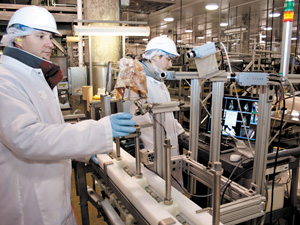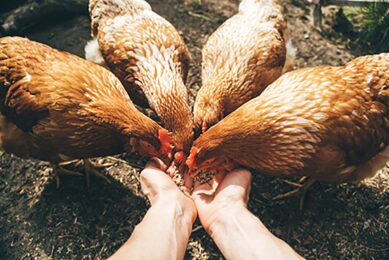Cone line screening: Improved yield, no bones about it!

Researchers at the Georgia Tech Research Institute perform in-plant tests of a cone line screening system. This automatically inspects for bones on the frame on the deboning line, providing immediate feedback to deboners.
By Georgia Tech Research Institute , Atlanta, GA, USA
Deboned breast fillets are one of the most popular further processed poultry products. However, sometimes bones missed during screening end up in the final product. This may be due to the fact that current screening methods are carried out post production by visual/manual or x-ray screening. The manual technique is error prone, and while the performance of x-ray systems has improved significantly, they are still expensive.
Additionally, in most installations, it is difficult to tie the occurrence of a bone back to the root cause of the problem. Researchers at the Georgia Tech Research Institute (GTRI) believe they may be on the verge of having a solution. Their cone line screening system automatically inspects for bones on the frame on the deboning line, providing immediate feedback to deboners on their individual performance and the overall efficiency of the line.
The screening system is also being adapted to estimate yield. Currently, the GTRI team is working on reliably measuring the yield of deboners in training, so that the poultry plant is able to monitor the performance of each individual. The team is also working on parametrising deboner fatigue based on the yield, so that plants can implement objective rotation schemes.
Missed bones
Daley and a team of fellow researchers together with a local equipment manufacturer began the development effort in early 2008 in response to the poultry industry’s concern of missed bones in the final product, particularly the clavicle and fan bones. A proof-of-concept “Missed bone screening system” and its potential as an automated alternative for quality control was then introduced.
| Detailed images of the camera registration are shown on the screen. | Screen shot of a good bird. |
In addition to integrating the system onto a fully functional cone line, the team redesigned the illuminated cone in an attempt to improve its maintainability. Besides the plastic cone developed for the proof-of-concept design, the team designed a hollow stainless steel cone. The design of the cone was improved by setting a single light source, rather than setting a light source on each cone, which reduces cost and complexity.
| Screen shot of a bird with a broken clavicle. | Screen shot of a bird with excess meat. |
In operation, the hollow cone passes over the light source, where a signal triggers the system’s near-infrared cameras and LEDs to capture an image of the frame. Tests at a Georgia poultry processing plant were recently conducted to evaluate the system’s performance in an actual production environment, specifically its ease of use, detection accuracy, and yield characterisation ability. Results are pending.
Operation of devices
If successful, researchers believe the system will provide processors the ability to exercise more control over their production by obtaining real-time control on the condition of the frames, which would provide information on the status of their production process (whether or not it is in or out of control). This should improve yield and reduce the possibility of bones and other undesirable products from the process ending up in the downstream output, decreasing the need for additional screening. This would also be a perfect solution for automated deboning systems to implement feedback control in the operation of devices.
MORE INFORMATION Reprinted from PoultryTech, a publication of the Agricultural Technology Research Programme of the Georgia Tech Research Institute, a programme conducted in cooperation with the Georgia Poultry Federation with funding from the Georgia Legislature. |













